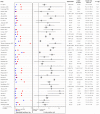The absolute and relative risk of type 2 diabetes after gestational diabetes: A systematic review and meta-analysis of 129 studies
- PMID: 33333204
- PMCID: PMC7610694
- DOI: 10.1016/j.diabres.2020.108625
The absolute and relative risk of type 2 diabetes after gestational diabetes: A systematic review and meta-analysis of 129 studies
Abstract
Aims: To estimate development of type 2 diabetes (T2DM) in women with previous gestational diabetes (GDM) and investigate characteristics associated with higher diagnoses, building on previous meta-analyses and exploring heterogeneity.
Methods: Systematic literature review of studies published up to October 2019. We included studies reporting progression to T2DM ≥6 months after pregnancy, if diagnostic methods were reported and ≥50 women with GDM participated. We conducted random-effects meta-analyses and meta-regression of absolute and relative T2DM risk.
Prospero id: CRD42017080299.
Results: In 129 included studies, the percentage diagnosed with T2DM was 12% (95% confidence interval 8-16%) higher for each additional year after pregnancy, with a third developing diabetes within 15 years. Development was 18% (5-34%) higher per unit BMI at follow-up, and 57% (39-70%) lower in White European populations compared to others (adjusted for ethnicity and follow-up). Women with GDM had a relative risk of T2DM of 8.3 (6.5-10.6). 17.0% (15.1-19.0%) developed T2DM overall, although heterogeneity between studies was substantial (I2 99.3%), and remained high after accounting for various study-level characteristics.
Conclusions: Percentage developing T2DM after GDM is highly variable. These findings highlight the need for sustained follow-up after GDM through screening, and interventions to reduce modifiable risk factors.
Keywords: Gestational diabetes; Incidence; Meta-analysis; Systematic review; Type 2 diabetes.
Copyright © 2020 The Author(s). Published by Elsevier B.V. All rights reserved.
Conflict of interest statement
Declaration of Competing Interest The authors declare that they have no known competing financial interests or personal relationships that could have appeared to influence the work reported in this paper.
Figures




References
-
- Ogurtsova K, da Rocha Fernandes JD, Huang Y, Linnenkamp U, Guariguata L, Cho NH, et al. IDF Diabetes Atlas: Global estimates for the prevalence of diabetes for 2015 and 2040. Diabetes Res Clin Pract. 2017;128:40–50. - PubMed
-
- International Diabetes Federation Diabetes Atlas. [Date last accessed: 01 Sept 2020];2019 Available from: http:\\www.diabetesatlas.org.
-
- Damm P. Future risk of diabetes in mother and child after gestational diabetes mellitus. Int J Gynecol Obstet. 2009;104:S25–S26. - PubMed
-
- Bommer C, Heesemann E, Sagalova V, Manne-Goehler J, Atun R, Bärnighausen T, et al. The global economic burden of diabetes in adults aged 20-79 years: a cost-of-illness study. Lancet Diabetes Endocrinol. 2017;5:423–30. - PubMed
Publication types
MeSH terms
Grants and funding
LinkOut - more resources
Full Text Sources
Other Literature Sources
Medical

